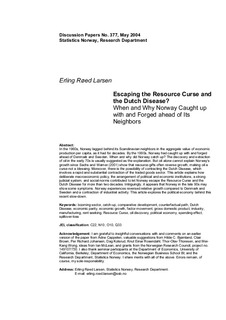Escaping the resource curse and the Dutch Disease? : when and why Norway caught up with and forged ahead of its neighbors
Working paper

Åpne
Permanent lenke
http://hdl.handle.net/11250/180569Utgivelsesdato
2004Metadata
Vis full innførselSamlinger
- Discussion Papers [1002]
Sammendrag
Abstract:
In the 1960s, Norway lagged behind its Scandinavian neighbors in the aggregate value of economic production per capita, as it had for decades. By the 1990s, Norway had caught up with and forged ahead of Denmark and Sweden. When and why did Norway catch up? The discovery and extraction of oil in the early 70s is usually suggested as the explanation. But oil alone cannot explain Norway's growth since Sachs and Warner (2001) show that resource-gifts often reverse growth, making oil a curse not a blessing. Moreover, there is the possibility of contracting the Dutch Disease, which involves a rapid and substantial contraction of the traded goods sector. This article explains how deliberate macroeconomic policy, the arrangement of political and economic institutions, a strong judicial system, and social norms contributed to let Norway escape the Resource Curse and the Dutch Disease for more than two decades. Intriguingly, it appears that Norway in the late 90s may show some symptoms. Norway experiences reversed relative growth compared to Denmark and Sweden and a contraction of industrial activity. This article explores the political economy behind this recent slow-down. _____ Keywords: booming sector, catch-up, comparative development, counterfactual path, Dutch Disease, economic parity, economic growth, factor movement, gross domestic product, industry, manufacturing, rent seeking, Resource Curse, oil discovery, political economy, spending effect, spillover-loss